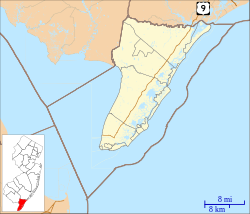Rufwud Cottage | |
 | |
| Location | 394 93rd Street, Stone Harbor, New Jersey |
|---|---|
| Coordinates | 39°03′28.1″N74°45′40.3″W / 39.057806°N 74.761194°W |
| Built | 1917 |
| Architect | Oscar Mons Hokanson |
| Architectural style | American Craftsman |
| NRHP reference No. | 14000979 [1] |
| NJRHP No. | 5189 [2] |
| Significant dates | |
| Added to NRHP | December 2, 2014 |
| Designated NJRHP | October 6, 2014 |
The Rufwud Cottage is located at 394 93rd Street in the borough of Stone Harbor in Cape May County, New Jersey, United States. The historic summer beach house was built in 1917 and features American Craftsman style. It was added to the National Register of Historic Places on December 2, 2014, for its significance in architecture. [1] It was designed by the master architect Oscar Mons Hokanson, who named it Rufwod (rough wood). Hokanson and his wife lived here during the summer months. He sold it to his wife's niece, Katherine C. Brown, in 1940. She sold it to her son, Christopher P. Brown, in 1989. [3]



